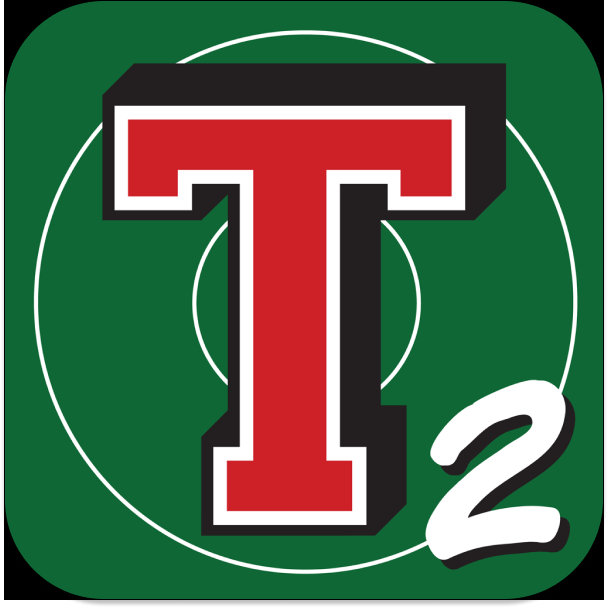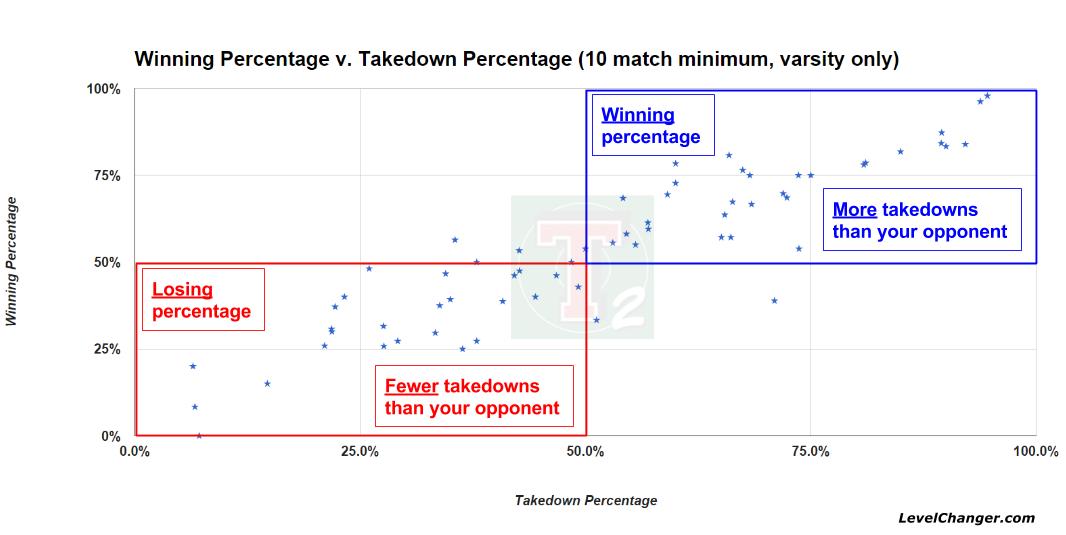Timely Information for Takedown Scoring and Stats Users
The Chart for Every Practice Room Wall
How important are takedowns?
We looked at over 2,000 matches for 63 wrestlers from six high school programs spread across the country and found that scoring more takedowns than your opponent is
How Important are Takedowns?
We looked at over 2,000 matches for 63 wrestlers from six high school programs spread across the country and found that scoring more takedowns than your opponent is highly correlated with having a winning season. Each wrestler had a minimum of ten matches and we considered only varsity events.
Thirty wrestlers scored on average the same or fewer takedowns than their opponent per match. Of these wrestlers, only three (10%) wrestlers had winning seasons. In contrast, thirty three wrestlers scored more takedowns, on average, than their opponent per match. Of these wrestlers, thirty one (94%) wrestlers had winning seasons.
The data supports what we instinctively know: takedown proficiency is critical to becoming a successful competitor. Next time an athlete says "prove it!", just post this graph on the practice room wall!
Statistics courtesty of Takedown Scoring and Stats app users.
Originally published October 2015.
Record Practice Attendance and Weight
Recording practice attendance and wrestler weights couldn’t be easier.
Takedown includes the ability to record practice attendance as well as wrestler weigh in and weigh out.
This helpful new feature is accessed in the selections under each Season.
Here’s a quick “how to” for using the feature.
Weigh information can be entered manually or wirelessly via Befour’s bluetooth enable scale. If budget permits, wireless entry is the way to go — simple, accurate and quick.
Associated with this feature are the Practice Attendance and Weight Management reports available in the Reports section of Takedown.
3 Tasks for Success
Here’s how to insure success using Takedown.
Using Takedown for the first time in live competition can be overwhelming. Here are three things you can do to get your scorers prepared for using Takedown in the live competition context.
1. Transcribe from Paper Scorebook
Copying matches from a paper scorebook is the first step. This context doesn’t have the pressure of a live situation so that the scorer can take their time and get familiar with the scoring interface. It also affords an opportunity to schedule and configure Events. The task should include a full dual meet and some tournament matches. The user shouldn’t be concerned with the match clock — just start it and enter the scoring, then move on to the next match. The goal here is to replicate the paper scorebook.
If you don’t have a paper scorebook handy, try this training exercise from our support site.
2. Score from Recorded Video
Any video recording of a wrestling match will do. It could be of your team or just some matches on YouTube. This is the next step-up in difficulty as the action is live but can be paused if necessary. Don’t worry about getting the names of the competitors correct. The goal of this task is to simulate the pace of live competition. Keeping the match clock accurate is an important skill development area.
3. Score Challenge Matches in the Practice Room
The last step, this is live competition without the pressure of a large audience and, perhaps, an impatient official. It’s a safe environment. In this task, all the skills developed in steps 1 and 2 will be tested at a live pace. In addition, the user should practice using the video recording feature.
In our experience, if your scorer follows these three steps, they’ll be successful when scoring and video recording live competition. When the training is done, you can simply delete the matches or events so that they don’t corrupt your analytics. You could also create a “Training” Season for all this activity and that would keep all the data separate from your competition seasons.
One Last Item
Add your managers/scorers to the Contacts portion of Takedown located at the top level in My Team. Doing this will add them to our mailing list so that they will be informed. When a manager/scorer moves on, they can easily unsubscribe from our mailing list.
What Does the Data Say About Short-Time Scoring?
To gauge the relevance of short-time scoring as a predictor of victory, we gathered data from 7,355 matches wrestled by 181 athletes at 13 high schools, all users of Takedown Scoring and Stats.
We filtered the data as follows:
Included varsity competition only
Included wrestlers with greater than 20 periods of short-time scoring data
Excluded exhibitions and forfeits from win-loss record
From this sample, we found the following:
With a negative Short-Time Scoring Average Point Advantage the probability of having a winning season is 41%.
With a zero or positive Average Point Advantage the probability of having a winning season is 82%.
This chart shows win percentage as a function of Average Point Advantage for this sample (each dot is a wrestler):
And, while the relevance of short-time scoring is hard to deny, we wondered if improved short-time scoring performance — a positive and increasing Average Point Advantage — is simply a matter of experience. That is, does advantage increase as a function of cumulative match experience?
Surprisingly, in this sample, the answer is no. There’s no meaningful correlation between experience (measured in matches) and short-time scoring performance.
So, we know (at least in this sample) that short-time scoring proficiency can increase one’s chances of having a winning season. It also appears that short-time scoring performance doesn’t naturally improve with experience. Maybe scoring in short-time is a skill (or perhaps a mindset) requiring focus and practice.
Something to think about for coaches wanting to help wrestlers get to the next level.
If you’re interested in tracking short-time scoring performance, check out Takedown Scoring and Stats.
A Word On Email Addresses and Contacts
Credentialing is the price we pay for online privacy.
Takedown is no different — every account needs a secure identity comprised of an email address and password.
If you want to ease credentialing headaches, here are a few tips.
Get a Team-Focused Email Address
The challenge with using a personal email address for logging in to Takedown (or YouTube) is that people — parents, coaches — move on, email addresses get deleted or the email owner becomes unreachable.
Get a team-focused Gmail address and use this address for logging in to Takedown and for uploading video. Gmail addresses are free and each one is automatically associated with a YouTube account.
Five Places to Use One Email Address
Make your life easier by using the same team-focused email address for these five items:
Takedown login credentials
Creating an Apple ID for purchasing Takedown subscriptions
YouTube uploads
Configuring Apple mail app
Creating an X(formerly Twitter) account and any other social media account
Takedown Primary Contact
In Takedown’s Contact manager, tag any entry as a ‘Primary Contact.’ This contact will receive all emails from us. Contacts not tagged as “Primary” will receive very few emails from us.
Your Takedown login email address is automatically tagged in our database as a “Primary Contact.” You do not need to add your log in email to the Takedown Contact manager.
Get Your Managers in the Loop
Keep your key people informed.
If you want to be successful with Takedown, get your managers onto our email list.
In Takedown, go to the top level in My Team and add their Contact information. The app will add them to our email list and then they’ll receive our weekly message with helpful information.
At the end of the Season, remove their information from Takedown Contacts if you’d like. Also, they can unsubscribe from our email list at any time — that capability is included at the bottom of all emails.
Major Fall Release: Takedown Scoring and Stats 3.3
Major release of Takedown Scoring and Stats. Revamped Reports with Filters and Sort.
Takedown Scoring and Stats 3.3, our major fall release, is available for download in the App Store. Recommended for all users
Revamped Reports
This release features totally revamped and greatly improved Reports including:
Separate controls for Filters, Sorting and Options
Better Filter layout to improve selection and navigation
Added Sorting to most reports.
Increased number of Sort options
User configurable column selection for multi-column tables and Leaderboard
Filter/Sort/Other Options configured and saved individually for each Report.
Improved and common formatting for better visual appeal and readability
Re-engineered content for some reports with an eye towards performance assessment
See these support articles for more details.
Additional Improvements
Compliance with revised NCAA rules for three point takedown and three point near fall.
More robust roster import from text file with a flexibile header row
Numerous bug fixes
Other Changes
Minimum operating system for Takedown 3.3 is iOS 15.
While video recording, it is no longer possible to go to another section of Takedown and continue recording. We made this change to improve video recording reliability.
Emerging from the Darkness: High School Wrestling Participation 2022-2023
NFHS wrestling participation for 2022-2023. Coming out of the COVID darkness and into the light, boys rebounding to 2014-2015 levels. As expected, strong growth in girls programs with one concerning metric.
The NFHS recently released their high school sports participaton data for 2022-2023. Total wrestling participants was 305,593, a record in this millenia, representing 16% growth from the previous survey year. This growth far outpaces the year-year growth in total high school sports participation which was 3.1%.
Overall, boys wrestling rebounded to levels not seen since 2014-2015. While the number of boys teams has remained roughly constant, the number of participants increased by 11% to 256,466.
Girls wrestling continues to grow like a weed with 49,127 participants in 6,381 programs representing year-year growth of 55% and 33%, respectively. One in six high school wrestlers was a girl in 2022-2023. One cloud for girls wrestling is the anemic growth in average team size which was reported at 7.7 wrestlers per team. At historical growth rates, the average girls team won’t be capable of filling a minimum dual meet roster for another 20+ years.
Among high school sports participants, wrestling’s popularity has increased a bit. Wrestling’s share of all high school sports participants edged up slightly from 3.5% to 3.9%, with boys at 5.7% and girls at 1.5%.
Click on any chart to enlarge.
Number of Wrestling Programs
Number of Participants
Wrestlers Per Team
Wrestling Share of High School Sports
Fog in the NCAA Wrestling Rules Committee
We might need to tap the brakes.
Recently, the NCAA wrestling rules committee proposed a slate of rule changes some of which involve scoring. Specifically, the committee proposed (1) increasing the point value for a takedown from two to three and (2) conditioning the riding time advantage point on earning a near fall.
One might reasonably assume the committee knows exactly what they’re trying to accomplish with these fundamental changes, and that they’ve developed some measurable success metrics.
Need for Situational Awareness
Various coaches, including the committee chair, have expressed the goals of the scoring changes as some variation of:
Avoiding undesirable scoring scenarios
Increasing excitement or ‘action’
These are meritorious goals to be sure.
So, let’s do it!
Not so fast.
The issue with proceeding might be twofold:
We don’t know where we are
We don’t know where we want to be
Data Free Decision-Making
Consider the goal of “avoiding undesirable scoring scenarios.“
Three questions should be answered before adopting a scoring change:
Which undesirable scoring scenarios? These scenarios? Any wrestling scoring scenario can be uniquely described as a sequence of scoring activity in specific periods.
How frequently do these scenarios occur now?
How frequently should these scenarios occur in the future?
Same argument goes for “increasing excitement or action.” What exactly does this mean?
Answering these questions revolves around collecting and analyzing data — readily available in Trackwrestling — and setting explicit objectives. For example, the committee might say:
“We want to reduce the occurrence of situations in which (describe scoring sequence here) is sufficient to win the match. Currently, this occurs in X% of all college matches. Our goal is to reduce this by (insert goal here). We are proposing (insert rule change here) to achieve this goal by (insert timeframe here).”
If this work hasn’t been done, then it is a matter of fact that we will never know if the proposed changes, if adopted, are effective.
And, that’s a bad outcome for wrestling.
Takedown v. Matboss
You don’t need another boss. You need help.
We are often asked “How does Takedown compare to Matboss?”
Here’s a comparison.









